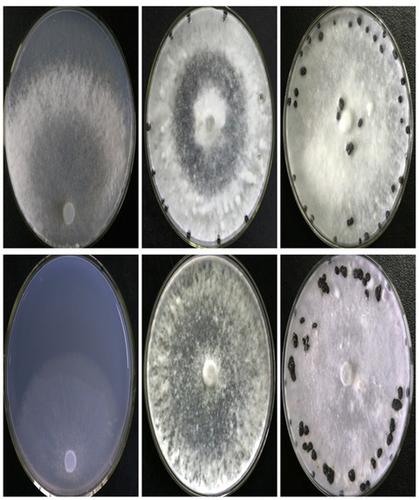当前位置:
X-MOL 学术
›
Mol. Plant Pathol.
›
论文详情
Our official English website, www.x-mol.net, welcomes your
feedback! (Note: you will need to create a separate account there.)
Sclerotinia sclerotiorum Thioredoxin1 (SsTrx1) is required for pathogenicity and oxidative stress tolerance
Molecular Plant Pathology ( IF 4.8 ) Pub Date : 2021-08-30 , DOI: 10.1111/mpp.13127 Kusum Rana 1, 2 , Yijuan Ding 1, 2 , Surinder S Banga 3 , Hongmei Liao 1, 2 , Siqi Zhao 1, 2 , Yang Yu 4 , Wei Qian 1, 2
Molecular Plant Pathology ( IF 4.8 ) Pub Date : 2021-08-30 , DOI: 10.1111/mpp.13127 Kusum Rana 1, 2 , Yijuan Ding 1, 2 , Surinder S Banga 3 , Hongmei Liao 1, 2 , Siqi Zhao 1, 2 , Yang Yu 4 , Wei Qian 1, 2
Affiliation

|
Sclerotinia sclerotiorum infects host plant tissues by inducing necrosis to source nutrients needed for its establishment. Tissue necrosis results from an enhanced generation of reactive oxygen species (ROS) at the site of infection and apoptosis. Pathogens have evolved ROS scavenging mechanisms to withstand host-induced oxidative damage. However, the genes associated with ROS scavenging pathways are yet to be fully investigated in S. sclerotiorum. We selected the S. sclerotiorum Thioredoxin1 gene (SsTrx1) for our investigations as its expression is significantly induced during S. sclerotiorum infection. RNA interference-induced silencing of SsTrx1 in S. sclerotiorum affected the hyphal growth rate, mycelial morphology, and sclerotial development under in vitro conditions. These outcomes confirmed the involvement of SsTrx1 in promoting pathogenicity and oxidative stress tolerance of S. sclerotiorum. We next constructed an SsTrx1-based host-induced gene silencing (HIGS) vector and mobilized it into Arabidopsis thaliana (HIGS-A) and Nicotiana benthamiana (HIGS-N). The disease resistance analysis revealed significantly reduced pathogenicity and disease progression in the transformed genotypes as compared to the nontransformed and empty vector controls. The relative gene expression of SsTrx1 increased under oxidative stress. Taken together, our results show that normal expression of SsTrx1 is crucial for pathogenicity and oxidative stress tolerance of S. sclerotiorum.
中文翻译:

核盘菌硫氧还蛋白 1 (SsTrx1) 是致病性和氧化应激耐受性所必需的
核盘菌通过诱导坏死来感染宿主植物组织,以获取其建立所需的营养。组织坏死是由于感染和细胞凋亡部位活性氧 (ROS) 生成增多所致。病原体已经进化出ROS清除机制来抵御宿主诱导的氧化损伤。然而,核盘菌中与ROS清除途径相关的基因尚未得到充分研究。我们选择了核盘菌硫氧还蛋白 1基因 ( SsTrx1 ) 进行研究,因为它的表达在核盘菌感染期间显着诱导。 RNA 干扰诱导的核盘菌SsTrx1沉默影响了体外条件下的菌丝生长速率、菌丝形态和菌核发育。这些结果证实了SsTrx1参与促进核盘菌的致病性和氧化应激耐受性。接下来,我们构建了基于SsTrx1的宿主诱导基因沉默 (HIGS) 载体,并将其转移到拟南芥(HIGS- A ) 和本塞姆氏烟草(HIGS- N ) 中。抗病性分析显示,与未转化和空载体对照相比,转化基因型的致病性和疾病进展显着降低。 SsTrx1的相对基因表达在氧化应激下增加。综上所述,我们的结果表明, SsTrx1的正常表达对于核盘菌的致病性和氧化应激耐受性至关重要。
更新日期:2021-10-15
中文翻译:

核盘菌硫氧还蛋白 1 (SsTrx1) 是致病性和氧化应激耐受性所必需的
核盘菌通过诱导坏死来感染宿主植物组织,以获取其建立所需的营养。组织坏死是由于感染和细胞凋亡部位活性氧 (ROS) 生成增多所致。病原体已经进化出ROS清除机制来抵御宿主诱导的氧化损伤。然而,核盘菌中与ROS清除途径相关的基因尚未得到充分研究。我们选择了核盘菌硫氧还蛋白 1基因 ( SsTrx1 ) 进行研究,因为它的表达在核盘菌感染期间显着诱导。 RNA 干扰诱导的核盘菌SsTrx1沉默影响了体外条件下的菌丝生长速率、菌丝形态和菌核发育。这些结果证实了SsTrx1参与促进核盘菌的致病性和氧化应激耐受性。接下来,我们构建了基于SsTrx1的宿主诱导基因沉默 (HIGS) 载体,并将其转移到拟南芥(HIGS- A ) 和本塞姆氏烟草(HIGS- N ) 中。抗病性分析显示,与未转化和空载体对照相比,转化基因型的致病性和疾病进展显着降低。 SsTrx1的相对基因表达在氧化应激下增加。综上所述,我们的结果表明, SsTrx1的正常表达对于核盘菌的致病性和氧化应激耐受性至关重要。











































 京公网安备 11010802027423号
京公网安备 11010802027423号